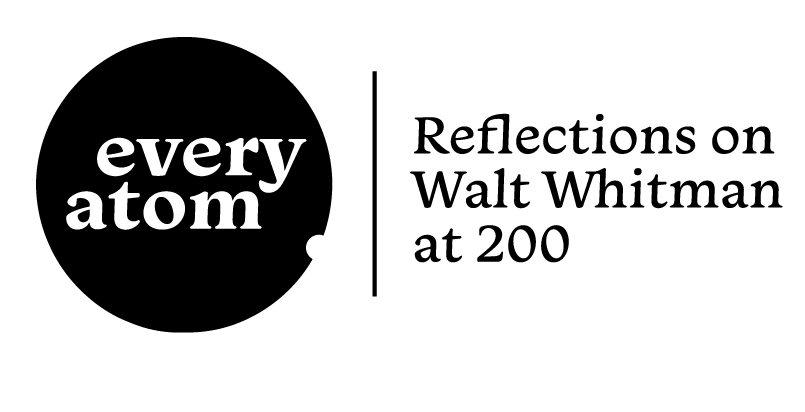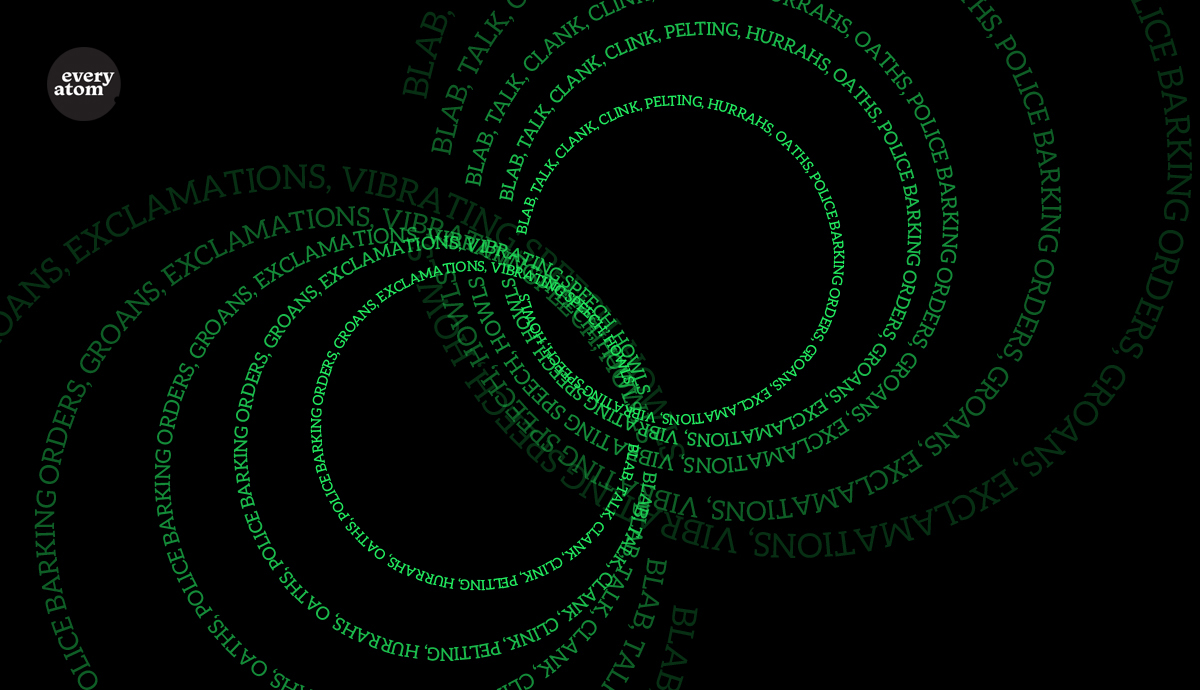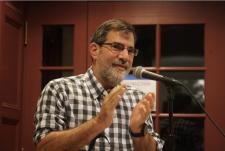Every Atom | No. 195
Introduction to Every Atom by project curator Brian Clements

The little one sleeps in its cradle,
I lift the gauze and look a long time, and silently brush away flies with my hand.
The youngster and the redfaced girl turn aside up the bushy hill,
I peeringly view them from the top.
The suicide sprawls on the bloody floor of the bedroom,
It is so . . . . I witnessed the corpse . . . . there the pistol had fallen.
The blab of the pave . . . . the tires of carts and sluff of bootsoles and talk of the promenaders,
The carnival of sleighs, the clinking and shouted jokes and pelts of snowballs;
The hurrahs for popular favorites . . . . the fury of roused mobs,
The flap of the curtained litter—the sick man inside, borne to the hospital,
The meeting of enemies, the sudden oath, the blows and fall,
The impassive stones that receive and return so many echoes,
The souls moving along . . . . are they invisible while the least atom of the stones is visible?
What groans of overfed or half-starved who fall on the flags sunstruck or in fits,
What exclamations of women taken suddenly, who hurry home and give birth to babes,
What living and buried speech is always vibrating here . . . . what howls restrained by decorum,
Arrests of criminals, slights, adulterous offers made, acceptances, rejections with convex lips,
I mind them or the resonance of them . . . . I come again and again.
In the section later to be numbered canto 8 we encounter the poem’s first urban list. It’s exciting! Enemies meet, and curse each other, and fight—yet no action verb is to be found in the vicinity! How did that happen?
Even the prefatory verbs (“sleeps” is the first—in “little one sleeps”) present mildest action. Prior to the pure catalogue of the famous fourth stanza, we barely encounter gestures as those observed are placed in a scene and the observer needs little syntactical initiative to do his seeing: “sleeps,” “silently brush away,” “turn aside,” “peeringly view.” This requires minimal labor and (a new sense of) urban work begins to seem the section’s main topic. The work of cataloguing implies its alliance with labor, in every senses: occupation, precarity, the People, birthing, the trades, struggle.
Canto 8 is soon a sound poem, reporting verblessly its enumeration of things heard before seen. Blab, talk, clank, clink, pelting, hurrahs, oaths, police barking orders, groans, exclamations, vibrating speech, howls. Whitman’s speaker sees, yes. But it’s not so much that he views or observes; rather, he “minds” what he hears. To mind here is passive but nonetheless powerful cognition, a blissful state everywhere for Whitman in “Song of Myself.” So much conflicting and simultaneous noise—at a wide diversity of sound registers—presents a “show or resonance” of social humanity.
To mind is also to protect, look after. From any conventional perspective, our poet has not been very successful at minding this city, if he had longed to keep it from danger. Not so secretly, despite his minding, he seeks the trouble that he avers is natural to the urban scene. And so I think of this section of the poem as an urban pastoral. “The blab of the pave” might as well be a babbling brook, that supposedly prelinguistic source. Yet “speech is always vibrating here.” Poets are supposed to take walks in a wood to hear what is always already sounding there, and then turn them into words. Amazingly, though, the pave provides just such inherent presence. “[H]owls restrain’d by decorum” are howlings nonetheless. What is left of decorum there? If the origin of Allen Ginsberg’s “Howl” is here—and it seems quite likely—then should we not read “Howl” as an American pastoral getting its start on this crazy throbbing boulevard? No restraint can succeed among the aural discordances of the city street. Active listening is a faux passivity. Ginsberg began with that particular paradoxical Whitmanian stance.
The “living and buried speech” of the pave in canto 8 is crucially meta-poetic, for it is the sound of the poem itself. The poem is one of those that does precisely what it talks about. The blab of the pave is the poem. Great poems hence will blab, respecting and gathering others’ labor rather than requiring, via the constraints of traditional poetic preparation, some great talented effort to discern it. I think of this canto as the first quasi-nonintentional chance operation. Notes toward an ambient poetics, and a guide. Come; listen; mind; depart.
Recommended
Nor’easter
Post-Op Appointment With My Father
Cedar Valley Youth Poet Laureate | Fall 2024 Workshop






